2007 CHEVROLET MALIBU key
[x] Cancel search: keyPage 1 of 510
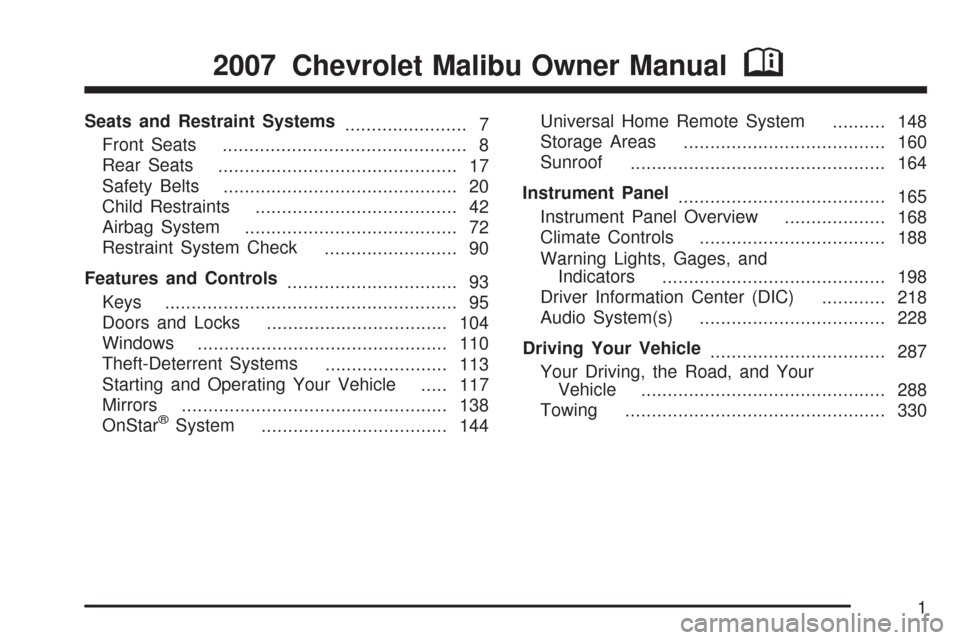
Seats and Restraint Systems
....................... 7
Front Seats
.............................................. 8
Rear Seats
............................................. 17
Safety Belts
............................................ 20
Child Restraints
...................................... 42
Airbag System
........................................ 72
Restraint System Check
......................... 90
Features and Controls
................................ 93
Keys
....................................................... 95
Doors and Locks
.................................. 104
Windows
............................................... 110
Theft-Deterrent Systems
....................... 113
Starting and Operating Your Vehicle
..... 117
Mirrors
.................................................. 138
OnStar
®System
................................... 144Universal Home Remote System
.......... 148
Storage Areas
...................................... 160
Sunroof
................................................ 164
Instrument Panel
....................................... 165
Instrument Panel Overview
................... 168
Climate Controls
................................... 188
Warning Lights, Gages, and
Indicators
.......................................... 198
Driver Information Center (DIC)
............ 218
Audio System(s)
................................... 228
Driving Your Vehicle
................................. 287
Your Driving, the Road, and Your
Vehicle
.............................................. 288
Towing
................................................. 330
2007 Chevrolet Malibu Owner ManualM
1
Page 34 of 510

Safety Belt Use During Pregnancy
Safety belts work for everyone, including pregnant
women. Like all occupants, they are more likely to
be seriously injured if they do not wear safety belts.
A pregnant woman should wear a lap-shoulder belt,
and the lap portion should be worn as low as
possible, below the rounding, throughout the
pregnancy.
The best way to protect the fetus is to protect the
mother. When a safety belt is worn properly, it is
more likely that the fetus will not be hurt in a crash.For pregnant women, as for anyone, the key to
making safety belts effective is wearing them
properly.
Right Front Passenger Position
To learn how to wear the right front passenger’s
safety belt properly, seeDriver Position on page 26.
The right front passenger’s safety belt works the
same way as the driver’s safety belt — except
for one thing. If you ever pull the shoulder portion
of the belt out all the way, you will engage the
child restraint locking feature. If this happens,
let the belt go back all the way and start again.
Rear Seat Passengers
It is very important for rear seat passengers to
buckle up! Accident statistics show that unbelted
people in the rear seat are hurt more often in
crashes than those who are wearing safety belts.
Rear passengers who are not safety belted can be
thrown out of the vehicle in a crash. And they
can strike others in the vehicle who are wearing
safety belts.
34
Page 93 of 510
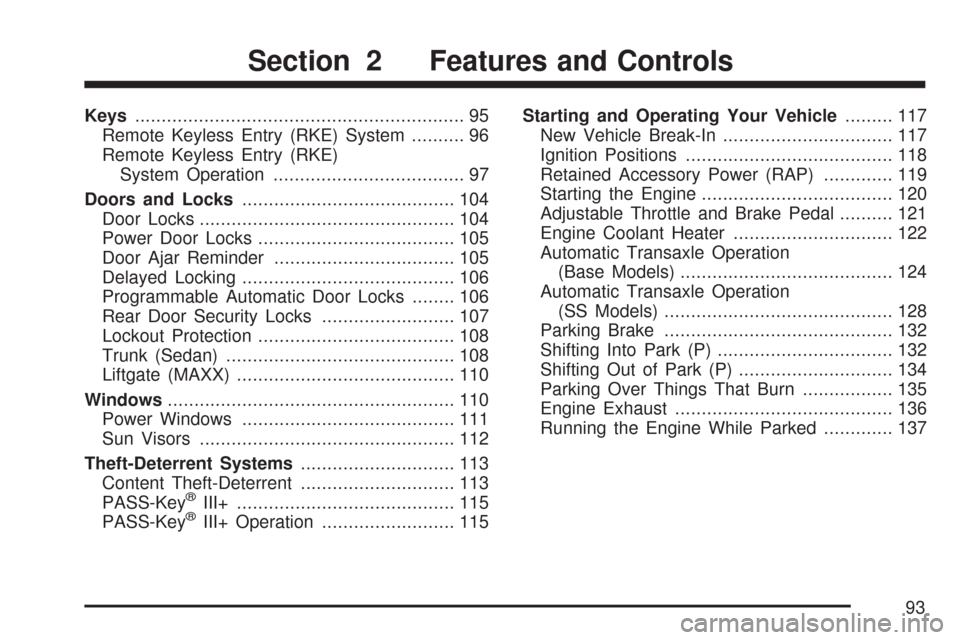
Keys.............................................................. 95
Remote Keyless Entry (RKE) System.......... 96
Remote Keyless Entry (RKE)
System Operation.................................... 97
Doors and Locks........................................ 104
Door Locks................................................ 104
Power Door Locks..................................... 105
Door Ajar Reminder.................................. 105
Delayed Locking........................................ 106
Programmable Automatic Door Locks........ 106
Rear Door Security Locks......................... 107
Lockout Protection..................................... 108
Trunk (Sedan)........................................... 108
Liftgate (MAXX)......................................... 110
Windows...................................................... 110
Power Windows........................................ 111
Sun Visors................................................ 112
Theft-Deterrent Systems............................. 113
Content Theft-Deterrent............................. 113
PASS-Key
®III+......................................... 115
PASS-Key®III+ Operation......................... 115Starting and Operating Your Vehicle......... 117
New Vehicle Break-In................................ 117
Ignition Positions....................................... 118
Retained Accessory Power (RAP)............. 119
Starting the Engine.................................... 120
Adjustable Throttle and Brake Pedal.......... 121
Engine Coolant Heater.............................. 122
Automatic Transaxle Operation
(Base Models)........................................ 124
Automatic Transaxle Operation
(SS Models)........................................... 128
Parking Brake........................................... 132
Shifting Into Park (P)................................. 132
Shifting Out of Park (P)............................. 134
Parking Over Things That Burn................. 135
Engine Exhaust......................................... 136
Running the Engine While Parked............. 137
Section 2 Features and Controls
93
Page 95 of 510
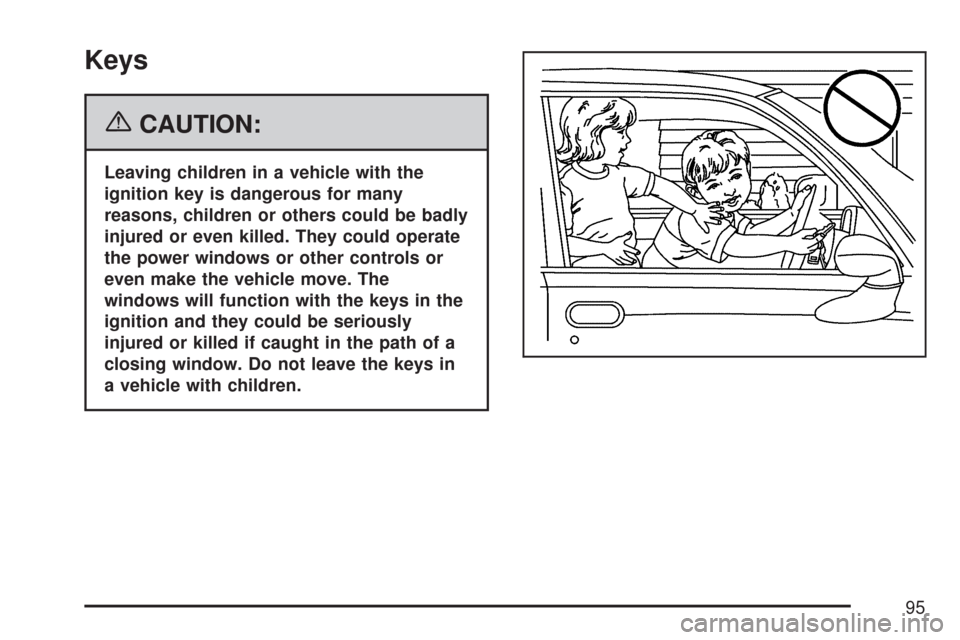
Keys
{CAUTION:
Leaving children in a vehicle with the
ignition key is dangerous for many
reasons, children or others could be badly
injured or even killed. They could operate
the power windows or other controls or
even make the vehicle move. The
windows will function with the keys in the
ignition and they could be seriously
injured or killed if caught in the path of a
closing window. Do not leave the keys in
a vehicle with children.
95
Page 96 of 510

One key is used for the
ignition and all locks.
When a new vehicle is delivered, the key has a
bar-coded key tag. This tag may be removed
by your dealer/retailer before it is delivered.
Each tag has a key code on it that tells your
dealer/retailer or a quali�ed locksmith how to
make extra keys. Keep the tag in a safe place.
If you lose your keys, you’ll be able to have
one made easily using this tag. If you need a
new key, go to your dealer/retailer for the correct
key code. SeeRoadside Assistance Program
on page 481for more information.
Notice:If you ever lock your keys in your
vehicle, you may have to damage the vehicle
to get in. Be sure you have spare keys.Remote Keyless Entry (RKE)
System
If the vehicle has the Remote Keyless Entry (RKE)
system, it operates on a radio frequency subject
to Federal Communications Commission (FCC)
Rules and with Industry Canada.
This device complies with Part 15 of the
FCC Rules. Operation is subject to the
following two conditions:
1. This device may not cause interference.
2. This device must accept any interference
received, including interference that may
cause undesired operation of the device.
This device complies with RSS-210 of Industry
Canada. Operation is subject to the following
two conditions:
1. This device may not cause interference.
2. This device must accept any interference
received, including interference that may
cause undesired operation of the device.
96
Page 97 of 510
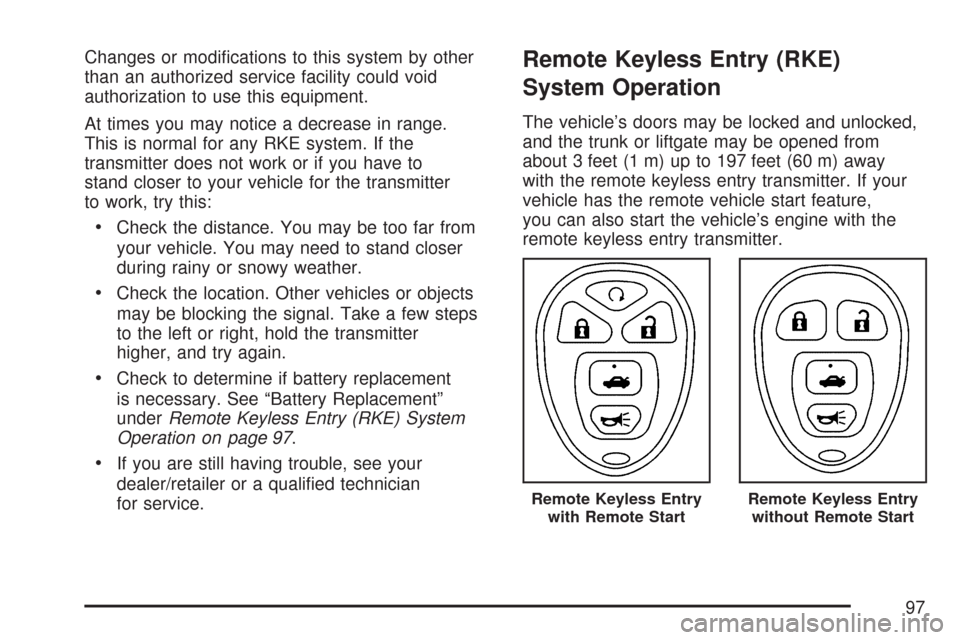
Changes or modi�cations to this system by other
than an authorized service facility could void
authorization to use this equipment.
At times you may notice a decrease in range.
This is normal for any RKE system. If the
transmitter does not work or if you have to
stand closer to your vehicle for the transmitter
to work, try this:
Check the distance. You may be too far from
your vehicle. You may need to stand closer
during rainy or snowy weather.
Check the location. Other vehicles or objects
may be blocking the signal. Take a few steps
to the left or right, hold the transmitter
higher, and try again.
Check to determine if battery replacement
is necessary. See “Battery Replacement”
underRemote Keyless Entry (RKE) System
Operation on page 97.
If you are still having trouble, see your
dealer/retailer or a quali�ed technician
for service.
Remote Keyless Entry (RKE)
System Operation
The vehicle’s doors may be locked and unlocked,
and the trunk or liftgate may be opened from
about 3 feet (1 m) up to 197 feet (60 m) away
with the remote keyless entry transmitter. If your
vehicle has the remote vehicle start feature,
you can also start the vehicle’s engine with the
remote keyless entry transmitter.
Remote Keyless Entry
with Remote StartRemote Keyless Entry
without Remote Start
97
Page 98 of 510
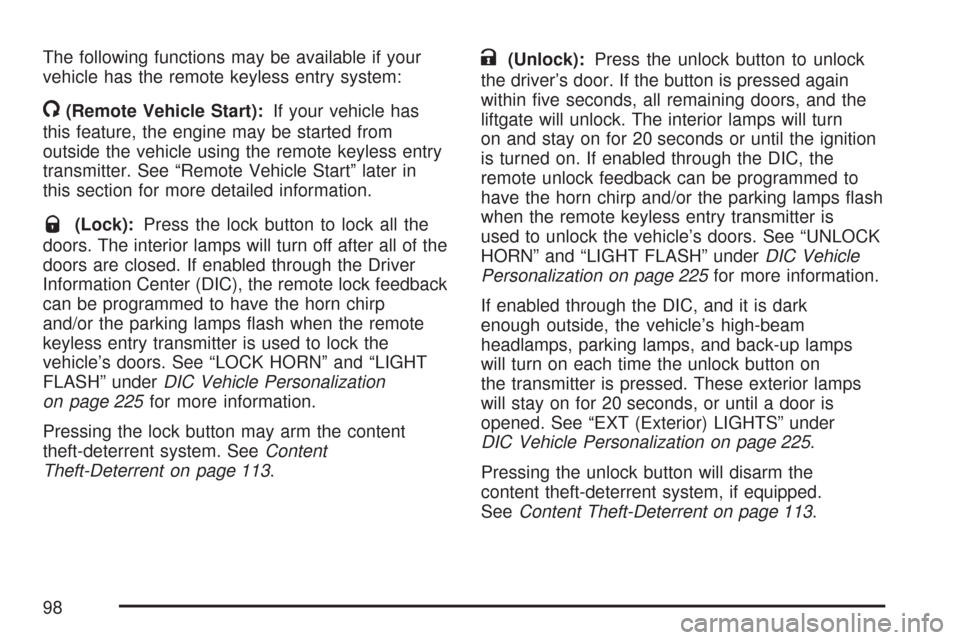
The following functions may be available if your
vehicle has the remote keyless entry system:
/(Remote Vehicle Start):If your vehicle has
this feature, the engine may be started from
outside the vehicle using the remote keyless entry
transmitter. See “Remote Vehicle Start” later in
this section for more detailed information.
Q(Lock):Press the lock button to lock all the
doors. The interior lamps will turn off after all of the
doors are closed. If enabled through the Driver
Information Center (DIC), the remote lock feedback
can be programmed to have the horn chirp
and/or the parking lamps �ash when the remote
keyless entry transmitter is used to lock the
vehicle’s doors. See “LOCK HORN” and “LIGHT
FLASH” underDIC Vehicle Personalization
on page 225for more information.
Pressing the lock button may arm the content
theft-deterrent system. SeeContent
Theft-Deterrent on page 113.
K(Unlock):Press the unlock button to unlock
the driver’s door. If the button is pressed again
within �ve seconds, all remaining doors, and the
liftgate will unlock. The interior lamps will turn
on and stay on for 20 seconds or until the ignition
is turned on. If enabled through the DIC, the
remote unlock feedback can be programmed to
have the horn chirp and/or the parking lamps �ash
when the remote keyless entry transmitter is
used to unlock the vehicle’s doors. See “UNLOCK
HORN” and “LIGHT FLASH” underDIC Vehicle
Personalization on page 225for more information.
If enabled through the DIC, and it is dark
enough outside, the vehicle’s high-beam
headlamps, parking lamps, and back-up lamps
will turn on each time the unlock button on
the transmitter is pressed. These exterior lamps
will stay on for 20 seconds, or until a door is
opened. See “EXT (Exterior) LIGHTS” under
DIC Vehicle Personalization on page 225.
Pressing the unlock button will disarm the
content theft-deterrent system, if equipped.
SeeContent Theft-Deterrent on page 113.
98
Page 99 of 510
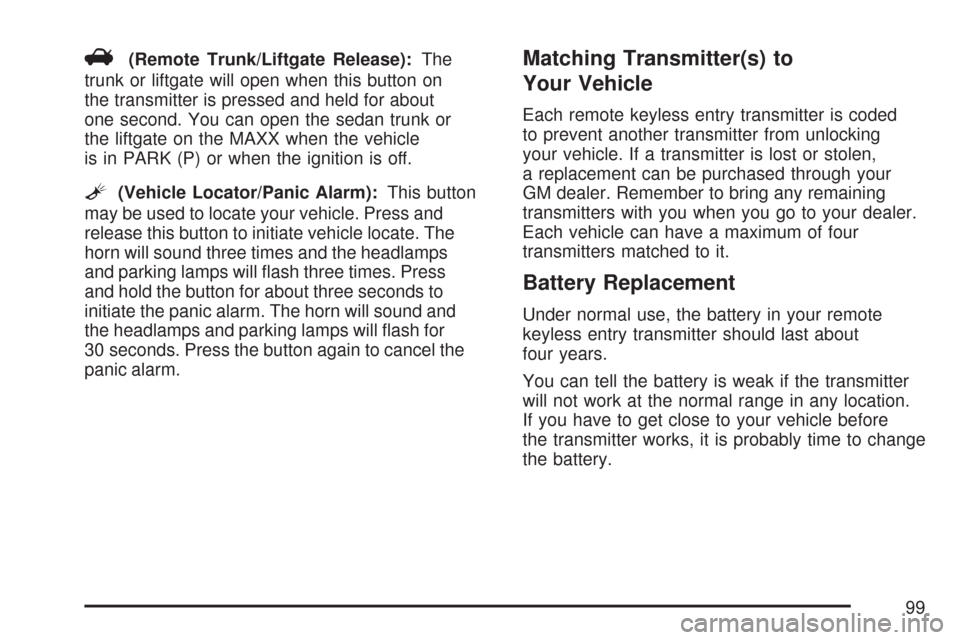
V(Remote Trunk/Liftgate Release):The
trunk or liftgate will open when this button on
the transmitter is pressed and held for about
one second. You can open the sedan trunk or
the liftgate on the MAXX when the vehicle
is in PARK (P) or when the ignition is off.
L(Vehicle Locator/Panic Alarm):This button
may be used to locate your vehicle. Press and
release this button to initiate vehicle locate. The
horn will sound three times and the headlamps
and parking lamps will �ash three times. Press
and hold the button for about three seconds to
initiate the panic alarm. The horn will sound and
the headlamps and parking lamps will �ash for
30 seconds. Press the button again to cancel the
panic alarm.
Matching Transmitter(s) to
Your Vehicle
Each remote keyless entry transmitter is coded
to prevent another transmitter from unlocking
your vehicle. If a transmitter is lost or stolen,
a replacement can be purchased through your
GM dealer. Remember to bring any remaining
transmitters with you when you go to your dealer.
Each vehicle can have a maximum of four
transmitters matched to it.
Battery Replacement
Under normal use, the battery in your remote
keyless entry transmitter should last about
four years.
You can tell the battery is weak if the transmitter
will not work at the normal range in any location.
If you have to get close to your vehicle before
the transmitter works, it is probably time to change
the battery.
99